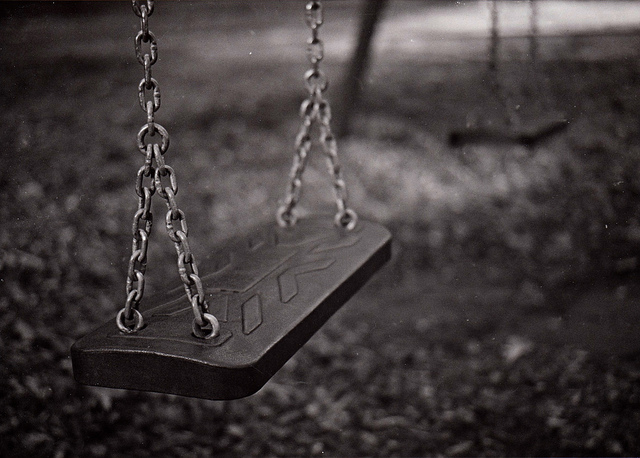
1.
As a newborn, my daughter hated being static. Whether bouncing, rocking, jiggling, or swinging, she made clear that she preferred to be moving. Thus, the infant swing became my savior. When my ears ached from her crying, and my muscles wilted from rocking her to sleep, I could set her down and have at least 20 minutes to recover. The soft tick tick tick of the swing was, for a brief period, an essential part of the soundtrack of our home.
Of course, her crying was not malicious. It was the only way she knew to express discomfort. The human brain develops over time, forming its initial architecture in the womb, then continuing to change throughout the life span. It is never static. But the foundational structures within our brains, the basic constructions and connections, are created during the first few years of life. During this time, a brain creates 700-1,000 new neural connections every second.[1] That meant that each time my baby daughter would swing forward, her brain created hundreds of new connections between neurons, and when she returned to my hand seconds later, there had been a thousand more again. Each time I pushed her away she returned a new and different person.
The technical language of Alzheimer’s is devastatingly beautiful. Hippocampus. Amyloid Plaques. Neurofibrillary tau tangles. My maternal grandmother was diagnosed with Alzheimer’s in her early eighties. However, that was long after the proteins in her brain had started to silently misfold, after she had already progressed through two or three of the five stages of the disease.
According to the Mayo Clinic, Alzheimer’s Disease “begins long before any symptoms become apparent” and progresses in five stages.[2] The first stage, that of Preclinical Alzheimer’s Disease, comes with no noticeable symptoms, although an image of the person’s brain would show the telltale plaques and tangles that begin to impede the communication between neurons. In fact, a study published in Neurology in July 2016 found that these changes could be seen already in the brains of genetically predisposed children as young as three years old.[3] By her late 60s, my grandmother had already lost two husbands and her eldest daughter. But she had not yet begun to lose herself.
2.
As my daughter grew, she did not lose her affinity for movement, or for swinging. Even now, when we arrive at the playground she makes a beeline for the swings, insisting I push her. She would willingly stay there, tilting her head to catch the breeze, for an hour or more. Lately, she has been working on learning to pump, so that she can swing on her own. Though the action seems simple at first, in teaching her I came to realize that pumping is more than flinging the legs forward and back. In reality, propelling a swing requires a complex mix of upper and lower body movements and shifting body weight. All of these actions have to work together to be successful. This is, so far, beyond her.
Playing on a swing helps children’s brains advance in a number of ways. The most obvious is practice in balance, coordination, and motor skills. Beyond this, the rocking motion of a swing has been found to be both calming and mood boosting. As a person swings, pressure on the skin receptors and stimulation of the inner ear release endorphins, producing a state of calm focus. Furthermore, swinging helps us become aware of our bodies in space. The changing planes and pressures that occur as the swing completes its arc give us a variety of stimuli to process and integrate.[4] In short, swinging literally teaches us how to be in the world.
My grandmother always brought gifts with her when she visited. Typically, garage sale treasures, magazine articles, or semi precious stones that she had unearthed from the piles of old things throughout her house. She was a collector. A hoarder. She could not resist a deal. More importantly, she could not see objects as separate from her potential future use for them. Everything stayed, and she built a cocoon around herself that no one was allowed inside.
As the second stage of Alzheimer’s, mild cognitive impairment, began to take effect, my grandmother may have noticed some changes to her memory and thinking ability. But she never would have told anyone if she did. Typically, these changes aren’t yet significant enough to interfere with work or relationships. My grandmother, like many, was able to conceal any changes from the world at this stage. Any gaffes were dismissed as part of her tendency toward the eccentric. She still knew how to be in the world.
3.
After the period of intense connection formation in early childhood, the brain goes through a process called “pruning”, which can last until early adulthood. In this phase, neural connections that are consistently being used are reinforced, while those that are less essential are trimmed.[5] Despite the fact that the brain is losing connections, this is not a detrimental process. Much like in gardening, the act of pruning keeps the plant (or brain) healthy. It directs resources toward the essential connections, allowing important brain circuits to become stronger and more efficient.
The pruning process is what lets us specialize. It helps us refine skills and specialties. It’s what allows us to become experts. In my daughter’s case, the repetition of swinging and the repeated attempts to pump her legs will eventually make the neural connections for these actions strong. Other connections will necessarily disappear to make room.
My grandmother was an expert in many things, one of which happened to be heirloom roses. She adored roses, and would often receive them as gifts. However, once home she didn’t take care of them. She would plant them in her backyard, and then let them go. No tending. No pruning. She’d let the plants wind around themselves and each other, tangle and fold.
By the time my grandmother entered the third stage of Alzheimer’s, mild dementia, the roses no longer brought her joy. Her personality began to change, and my family began to notice something was severely amiss. People in this stage of Alzheimer’s can begin to have problems with short-term memory, and my grandmother did. She began to repeat stories from her childhood, but could not remember what had happened earlier in the day. She had a number of car accidents, and became lost on familiar routes. Like my toddler, she would ask the same question over and over. She began to search for words for her favorite things, like the rose variety Plum Crazy.
4.
Sometimes I think my daughter enjoys swinging for the sheer repetition of it. The back and forth motion is predictable. Calming. Safe.
At two years old she began to throw tantrums. Screaming, hissing, seething tantrums that left me wondering where my sweet child had gone. Of course, I knew that tantrums are a normal part of being a young child. At two or three years old a child’s frontal lobe, the part responsible for logic, reasoning, and self-control is massively underdeveloped.[6] This makes for a person who is living in the moment; who isn’t necessarily being defiant, but is incapable of remembering and following the rules.
Many tantrums settled around transitions, like leaving a location. Some of the worst of these happened at the playground. No matter how many warnings I would give her (“one more minute” or “five more pushes”) or how I tried to reason with her (“your friend has been waiting 20 minutes for her turn”), there was nearly always a problem when it was time to get off the swing. I tried to make the neural connections for her, to set the links of the chain in place, but it rarely made a difference. No matter how hard her young brain was working, she did not yet have the capacity to understand cause and effect, the rules of the world.
My grandmother was likely in the fourth stage of Alzheimer’s, Moderate Dementia, when she was officially diagnosed. People in this stage show deepening confusion and poor judgment. They lose the ability to reason. By this time she could no longer take care of herself, her house, her dog. The steps necessary for daily activities would overwhelm her. My mother and aunt had to take away her keys, move her out of her house, and place her in a facility with 24-hour supervision.
In that first facility, my grandmother still showed vestiges of her self. She would collect the tiny creamer cups and sugar packets from the dining room, socking them away in her top drawer. She had intentions of going to the library, of continuing to read and write as she always had. But none of this happened. Instead she grew combative, especially around times of transition. She would lash out at the aides who tried to help her bathe. Refused to take her medications. Could not see the relationship between action and consequence. Like links in a chain, her neurons were disconnecting, snapping the thought processes that tethered her to the world.
5.
My daughter is now in preschool, and she becomes more herself each day. She is able to follow rules (sometimes), to make reasoned choices (mostly), and yes, is beginning to pump her legs on the swings.
Unfortunately, she was never able to meet her great-grandmother. Upon entering the fifth, and final, stage of Alzheimer’s disease, called Severe Dementia, my grandmother had to be placed in a facility that had full nursing care. At this stage, not only does the disease impact memory and thought processes, but it begins to take away the ability to communicate, to walk, and eventually to do most of the basic functions needed to sustain life, like swallow. After years of losing every part of her self, my grandmother lapsed into an intermittent coma.
At about three months old, my daughter showed us one of the first glimpses of her personality: her sense of humor. Peek-a-boo on the swings was hilarious fun, and she would collapse into giggles each time we played. One time, I managed to catch it on video. It was a short clip of pure joy, the unfettered giggling of a new baby.
At the next visit to my grandmother, my mother decided to play the video. Though my grandmother was not conscious, it did no harm to talk to her. My mother said, “This is your great-granddaughter,” and pressed the button. At the first giggle, my grandmother’s lips pressed, turned, and she smiled. There, after all of the undoing Alzheimer’s had done, was a rogue neural connection, a wisp of recognition, a lone survivor. And then just as quickly, it was gone.
***
[1] http://developingchild.harvard.edu/science/key-concepts/brain-architecture/
[2] http://www.mayoclinic.org/diseases-conditions/alzheimers-disease/in-depth/alzheimers-stages/art-20048448
[3] http://www.wsj.com/articles/alzheimers-gene-affects-early-brain-development-study-suggests-1468440000
[4] http://blog.schoolspecialty.com/special-needs/benefits-of-swinging/
[5] http://developingchild.harvard.edu/science/key-concepts/brain-architecture/
[6]http://www.slate.com/articles/double_x/the_kids/2013/02/why_does_my_kid_freak_out_the_science_behind_toddler_tantrums.html
 Ruth Kogen Goodwin is a writer and editor living in Southern California with her husband and their daughter. Her work has appeared on Kveller.com and in COG Magazine, Eclectica Magazine, the Eunoia Review, and Vine Leaves Literary Journal, among other publications. She received an MFA in creative writing from American University. Find out more at www.ruthkgoodwin.com.
Ruth Kogen Goodwin is a writer and editor living in Southern California with her husband and their daughter. Her work has appeared on Kveller.com and in COG Magazine, Eclectica Magazine, the Eunoia Review, and Vine Leaves Literary Journal, among other publications. She received an MFA in creative writing from American University. Find out more at www.ruthkgoodwin.com.
STORY IMAGE CREDIT: Flickr Creative Commons/Lars Von Wedel


